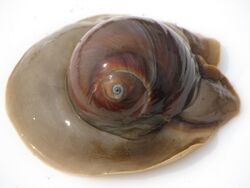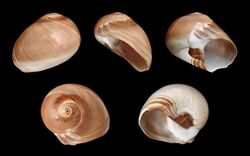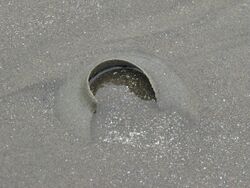Biology:Neverita didyma
From HandWiki
Short description: Species of mollusc
| Neverita didyma | |
|---|---|

| |
| A live and active individual of Neverita didyma, viewed from above | |

| |
| Five views of a shell of Neverita didyma | |
| Scientific classification | |
| Kingdom: | |
| Phylum: | |
| Class: | |
| (unranked): | |
| Superfamily: | |
| Family: | |
| Genus: | |
| Species: | N. didyma
|
| Binomial name | |
| Neverita didyma (Röding, 1798)
| |
| Synonyms[1] | |
| |
Neverita didyma, common name the bladder moon snail or moon shell, is a species of predatory sea snail, a marine gastropod mollusc in the family Naticidae, the moon snails.[1]
Subspecies
- Neverita didyma ampla (Philippi, 1849)
- Neverita didyma hayashii (Azuma, 1961)
- Neverita didyma hosoyai (Kira, 1959)
Description
The size of an adult shell of this species varies between 20 mm and 90 mm. Like all naticids, this species is a carnivore and a predator.
Distribution
This marine species is found in the Yellow Sea or off the coast of the Madagascar , Mozambique and South Africa of the Indian Ocean.
Culinary use

Golbaengi-muchim (moon snail salad)
In Korean cuisine the snails are used in a dish called golbaengi-muchim (moon snail salad).[2]
References
- ↑ 1.0 1.1 Neverita didyma (Röding, 1798). WoRMS (2009). Neverita didyma (Röding, 1798) 5. Accessed through the World Register of Marine Species at http://www.marinespecies.org/aphia.php?p=taxdetails&id=568320 on 14 April 2011 .
- ↑ National Institute of Korean Language (30 July 2014). "주요 한식명(200개) 로마자 표기 및 번역(영, 중, 일) 표준안" (in ko) (PDF). http://www.korean.go.kr/common/download.do?file_path=notice&c_file_name=140730_%ED%95%9C%EC%8B%9D%EB%AA%85_%EB%A1%9C%EB%A7%88%EC%9E%90_%ED%91%9C%EA%B8%B0_%EB%B0%8F_%ED%91%9C%EC%A4%80_%EB%B2%88%EC%97%AD_%ED%99%95%EC%A0%95%EC%95%88_.pdf&o_file_name=140730_%ED%95%9C%EC%8B%9D%EB%AA%85_%EB%A1%9C%EB%A7%88%EC%9E%90_%ED%91%9C%EA%B8%B0_%EB%B0%8F_%ED%91%9C%EC%A4%80_%EB%B2%88%EC%97%AD_%ED%99%95%EC%A0%95%EC%95%88_.pdf.
- 주요 한식명 로마자 표기 및 표준 번역 확정안 공지. National Institute of Korean Language (Press release) (in 한국어). 2014-05-02.
- Dautzenberg, Ph. (1929). Mollusques testacés marins de Madagascar. Faune des Colonies Francaises, Tome III
- MacNae, W. & M. Kalk (eds) (1958). A natural history of Inhaca Island, Mozambique. Witwatersrand Univ. Press, Johannesburg. I-iv, 163 pp.
- Branch, G.M. et al. (2002). Two Oceans. 5th impression. David Philip, Cate Town & Johannesburg
- Kilburn, R.N. & Rippey, E. (1982) Sea Shells of Southern Africa. Macmillan South Africa, Johannesburg, xi + 249 pp. page(s): 71
- Steyn, D.G. & Lussi, M. (1998) Marine Shells of South Africa. An Illustrated Collector’s Guide to Beached Shells. Ekogilde Publishers, Hartebeespoort, South Africa, ii + 264 pp. page(s): 50
- Hollman M. (2008) Naticidae. In Poppe G.T. (ed.) Philippine marine mollusks, vol. 1: 482-501, pls 186-195. Hackenheim: Conchbooks.
- Torigoe K. & Inaba A. (2011) Revision on the classification of Recent Naticidae. Bulletin of the Nishinomiya Shell Museum 7: 133 + 15 pp., 4 pls
External links
- "Polinices (Glossaulax) didyma" (in en). Gastropods.com. http://www.gastropods.com/6/Shell_2696.shtml.
- Seashells of NSW info
Wikidata ☰ Q881786 entry
 |


